Even though it is not the largest identifiable grove of Sequoias,
Giant Forest is the most accessible large grove and has 4 of the
5 largest (by volume) Sequoias (Sherman, Washington, President, Lincoln).
The National Geographic magazine covered the President in late 2012.
With the removal of the cabins from the Sequoia Grove,
there are more trails available. The Giant Forest Webcam is a view toward
the San Joaquin Valley, not the forest. This is in keeping with its role
in pollution and visibility monitoring. Two others cameras
are at the low elevation Buckeye visitor center.
Visit the museum, the trails, Moro Rock. In the winter X-Country skiing is
the way to go.
Major attractions include Crescent Meadow, the General Sherman Tree,
Congress Grove, access to Moro Rock (which lies outside the Sequoia zone
but is essentially in Giant Forest),
and many other short and long trails. The (summer) shuttles provide
connections from
the museum area to Crescent Meadow via Moro Rock (Route 2, Gray);
or the General Sherman tree and on to Lodgepole (Campground, Visitor Center)
(Route 1, Green);
and Dorst Campground via Wuksachi (lodge) from Lodgepole (Route 3, Purple).
A new, less frequent shuttle connects Wolverton (trail head parking)
to the Upper and Lower Sherman Tree stops.
The shuttles make the walk from Crescent
Meadow to the General Sherman Tree very easy to manage. And it is not as far
as it seems when you drive between them.
The routes are designed to be less than 30 minutes long so it is easy to
maintain the 15 minute spacing.
The park shuttles connects with the
bus (not free) to Visalia.
 General Sherman from the "standard" view. This used to be
the view as you walked from the parking lot. In order to restore more of the
sequoia habitat, the parking lot has been moved to the pine forest
above the grove. Handicap
parking and the shuttle stop are available at the highway.
By the usual definition (single trunk tree), this is the largest living
specimen on earth. The walkway and fence are about the same for the last 50
or so years, though the earlier versions were kept completely free of needles
from the trees.
General Sherman from the "standard" view. This used to be
the view as you walked from the parking lot. In order to restore more of the
sequoia habitat, the parking lot has been moved to the pine forest
above the grove. Handicap
parking and the shuttle stop are available at the highway.
By the usual definition (single trunk tree), this is the largest living
specimen on earth. The walkway and fence are about the same for the last 50
or so years, though the earlier versions were kept completely free of needles
from the trees.
|
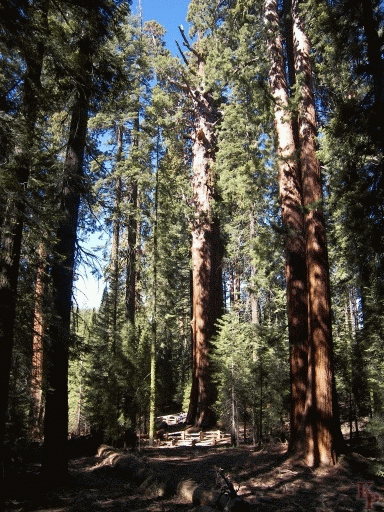 The General Sherman tree from the "back" side. This view
point is at a specially selected point on the the new trail. You are about
half way down from the parking area (total of 0.5 miles down).
The view area has an outline of the base of the tree.
The General Sherman tree from the "back" side. This view
point is at a specially selected point on the the new trail. You are about
half way down from the parking area (total of 0.5 miles down).
The view area has an outline of the base of the tree.
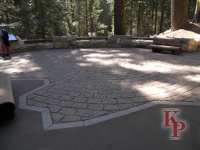
|
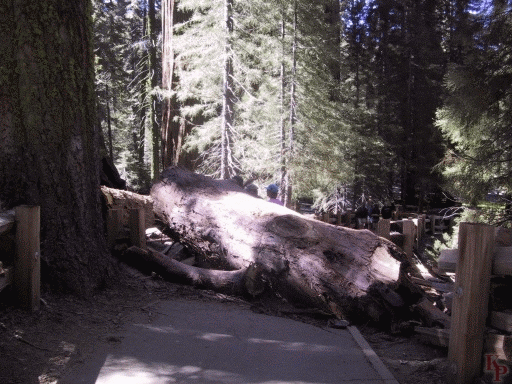 The General Sherman
lost a large limb in the winter of 2006.
The new parking lot and trail had opened earlier in 2006, just in time
for the new
fence and walkway to be crushed. The limb is thicker than most trees, but
there are larger limbs still on the tree. The limb remains with the fence
and walkway routed around it. The limb was not large enough to
reduce the General Sherman to #2, but similar limbs on other trees could
change their size ranking.
The General Sherman
lost a large limb in the winter of 2006.
The new parking lot and trail had opened earlier in 2006, just in time
for the new
fence and walkway to be crushed. The limb is thicker than most trees, but
there are larger limbs still on the tree. The limb remains with the fence
and walkway routed around it. The limb was not large enough to
reduce the General Sherman to #2, but similar limbs on other trees could
change their size ranking.
|
Starting from the standard Sherman view point, you should
take the Congress trail.
Few other people take this trail since it is more then 100 yards from the
road. There are a number of photogenic clusters (e.g. the House and
the Senate) and several presidential trees (there is a good view
of the McKinley tree, take the side trail to the really good view), all
of this with a pleasent walk away from the crowd. You can also see the former
Telescope tree, which also fell in the winter of 2006.
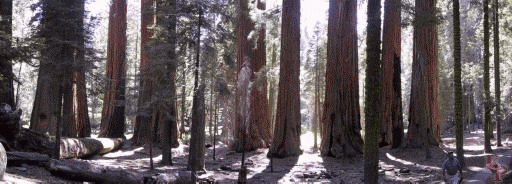
|
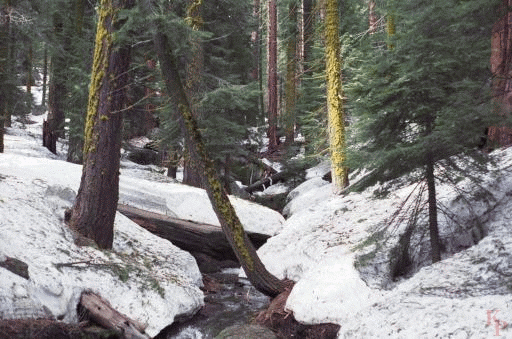 This may look like
winter, but it was taken in June. Or as a different June shows, the weather
varies by year and by season.
This may look like
winter, but it was taken in June. Or as a different June shows, the weather
varies by year and by season.
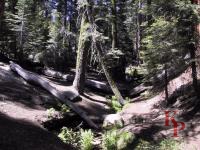
|
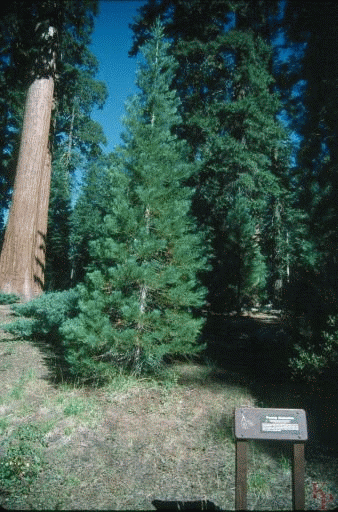 Most pictures you see are the grand old monarchs, but they
all started as young trees. As young trees, they look like regular trees --
the rounded top of the mature sequoia comes later.
Most pictures you see are the grand old monarchs, but they
all started as young trees. As young trees, they look like regular trees --
the rounded top of the mature sequoia comes later.
|
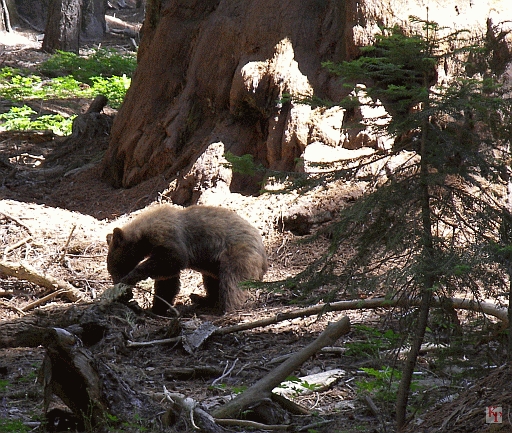 One of the permanent residents.
They were here first, they are here when we leave.
Take care of your food, be careful with your trash and enjoy the few times
you see one, especially when out walking. All of those unseen loud
cracks you hear walking are bears tearing into logs looking for insects.
Note that the usual name of Black Bear, Brown Bear, etc. is meaningless
for the
Ursus americanus.
The color variations within the species are large and overlap others.
One of the permanent residents.
They were here first, they are here when we leave.
Take care of your food, be careful with your trash and enjoy the few times
you see one, especially when out walking. All of those unseen loud
cracks you hear walking are bears tearing into logs looking for insects.
Note that the usual name of Black Bear, Brown Bear, etc. is meaningless
for the
Ursus americanus.
The color variations within the species are large and overlap others.
|
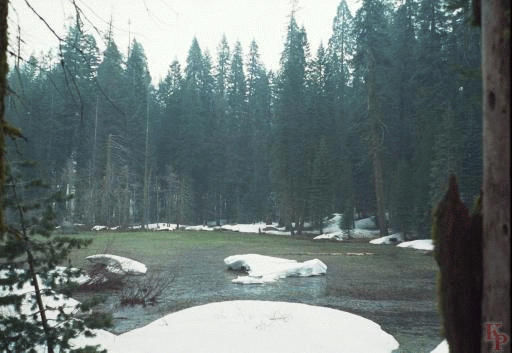 Crescent Meadow is a gem of the sierra. There are flowers
in the spring after snowmelt (unlike this year, June usually qualifies as
spring). Stay out of the fragile meadow -- the trail is behind
the tree line and provides many views across the meadow.
A variety of trails are available, including loops and connections
to the Congress Grove and General Sherman shuttle stop.
Crescent Meadow is a gem of the sierra. There are flowers
in the spring after snowmelt (unlike this year, June usually qualifies as
spring). Stay out of the fragile meadow -- the trail is behind
the tree line and provides many views across the meadow.
A variety of trails are available, including loops and connections
to the Congress Grove and General Sherman shuttle stop.
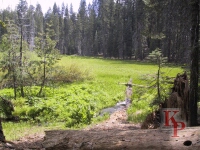
|
 Moro Rock provides a good view with a short hike and crowds of people.
I prefer the view from Eagle View or Bobcat View (the trail is better
and more obvious to Eagle View).
The Kern-Kaweah ridge forms the eastern
horizon. The higher Sierra Nevada crest is beyond this and is generally
not visible from the western part of the park.
Moro Rock provides a good view with a short hike and crowds of people.
I prefer the view from Eagle View or Bobcat View (the trail is better
and more obvious to Eagle View).
The Kern-Kaweah ridge forms the eastern
horizon. The higher Sierra Nevada crest is beyond this and is generally
not visible from the western part of the park.
|
 General Sherman from the "standard" view. This used to be
the view as you walked from the parking lot. In order to restore more of the
sequoia habitat, the parking lot has been moved to the pine forest
above the grove. Handicap
parking and the shuttle stop are available at the highway.
By the usual definition (single trunk tree), this is the largest living
specimen on earth. The walkway and fence are about the same for the last 50
or so years, though the earlier versions were kept completely free of needles
from the trees.
General Sherman from the "standard" view. This used to be
the view as you walked from the parking lot. In order to restore more of the
sequoia habitat, the parking lot has been moved to the pine forest
above the grove. Handicap
parking and the shuttle stop are available at the highway.
By the usual definition (single trunk tree), this is the largest living
specimen on earth. The walkway and fence are about the same for the last 50
or so years, though the earlier versions were kept completely free of needles
from the trees.
 The General Sherman tree from the "back" side. This view
point is at a specially selected point on the the new trail. You are about
half way down from the parking area (total of 0.5 miles down).
The view area has an outline of the base of the tree.
The General Sherman tree from the "back" side. This view
point is at a specially selected point on the the new trail. You are about
half way down from the parking area (total of 0.5 miles down).
The view area has an outline of the base of the tree.
 The General Sherman
lost a large limb in the winter of 2006.
The new parking lot and trail had opened earlier in 2006, just in time
for the new
fence and walkway to be crushed. The limb is thicker than most trees, but
there are larger limbs still on the tree. The limb remains with the fence
and walkway routed around it. The limb was not large enough to
reduce the General Sherman to #2, but similar limbs on other trees could
change their size ranking.
The General Sherman
lost a large limb in the winter of 2006.
The new parking lot and trail had opened earlier in 2006, just in time
for the new
fence and walkway to be crushed. The limb is thicker than most trees, but
there are larger limbs still on the tree. The limb remains with the fence
and walkway routed around it. The limb was not large enough to
reduce the General Sherman to #2, but similar limbs on other trees could
change their size ranking.

 This may look like
winter, but it was taken in June. Or as a different June shows, the weather
varies by year and by season.
This may look like
winter, but it was taken in June. Or as a different June shows, the weather
varies by year and by season.
 Most pictures you see are the grand old monarchs, but they
all started as young trees. As young trees, they look like regular trees --
the rounded top of the mature sequoia comes later.
Most pictures you see are the grand old monarchs, but they
all started as young trees. As young trees, they look like regular trees --
the rounded top of the mature sequoia comes later.
 One of the permanent residents.
They were here first, they are here when we leave.
Take care of your food, be careful with your trash and enjoy the few times
you see one, especially when out walking. All of those unseen loud
cracks you hear walking are bears tearing into logs looking for insects.
Note that the usual name of Black Bear, Brown Bear, etc. is meaningless
for the
Ursus americanus.
The color variations within the species are large and overlap others.
One of the permanent residents.
They were here first, they are here when we leave.
Take care of your food, be careful with your trash and enjoy the few times
you see one, especially when out walking. All of those unseen loud
cracks you hear walking are bears tearing into logs looking for insects.
Note that the usual name of Black Bear, Brown Bear, etc. is meaningless
for the
Ursus americanus.
The color variations within the species are large and overlap others.
 Crescent Meadow is a gem of the sierra. There are flowers
in the spring after snowmelt (unlike this year, June usually qualifies as
spring). Stay out of the fragile meadow -- the trail is behind
the tree line and provides many views across the meadow.
A variety of trails are available, including loops and connections
to the Congress Grove and General Sherman shuttle stop.
Crescent Meadow is a gem of the sierra. There are flowers
in the spring after snowmelt (unlike this year, June usually qualifies as
spring). Stay out of the fragile meadow -- the trail is behind
the tree line and provides many views across the meadow.
A variety of trails are available, including loops and connections
to the Congress Grove and General Sherman shuttle stop.
 Moro Rock provides a good view with a short hike and crowds of people.
I prefer the view from Eagle View or Bobcat View (the trail is better
and more obvious to Eagle View).
The Kern-Kaweah ridge forms the eastern
horizon. The higher Sierra Nevada crest is beyond this and is generally
not visible from the western part of the park.
Moro Rock provides a good view with a short hike and crowds of people.
I prefer the view from Eagle View or Bobcat View (the trail is better
and more obvious to Eagle View).
The Kern-Kaweah ridge forms the eastern
horizon. The higher Sierra Nevada crest is beyond this and is generally
not visible from the western part of the park.
 Return to my Sequoia Kings Canyon home page.
Return to my Sequoia Kings Canyon home page.